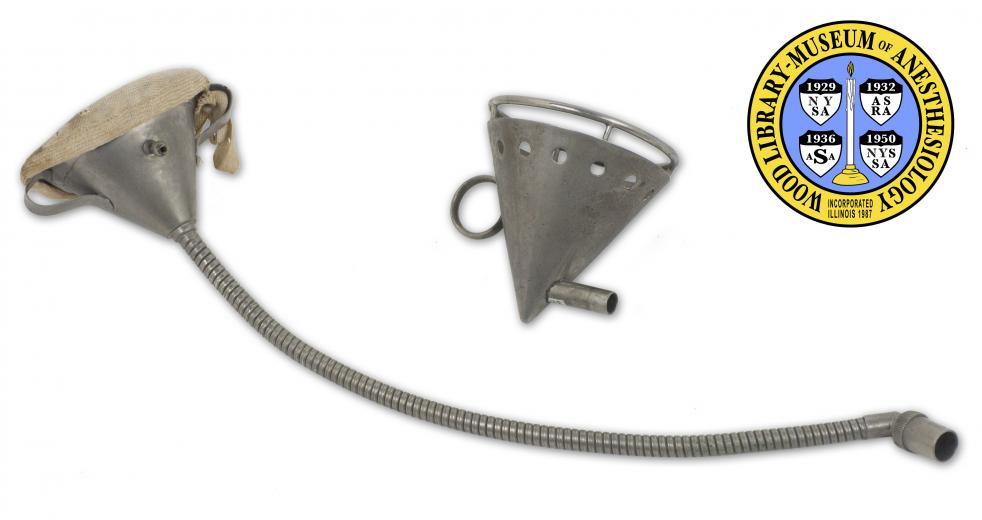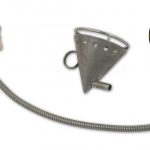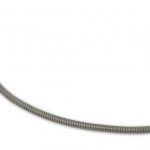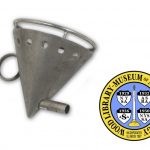Trendelenburg Cone
Anesthesiologists help patients breathe by using a number of devices. Most of these, such as airways and laryngoscopes, are inserted through the open mouth. But in some cases, such as oral surgery, that would be impractical.
This apparatus delivers the anesthetic through a surgical opening in the patient's trachea (windpipe.) The technique of endotracheal anesthesia was introduced in 1871 by the German surgeon, Friedrich Trendelenburg (1844-1924). Ether or chloroform would be dripped onto a cloth, stretched over a frame inside the cone to promote evaporation. The cone itself has a series of holes that allow fresh air to mix with the anesthetic vapor inhaled by the patient. The long tube, stiffened by spiral wire, allowed the anesthetist to work at a distance of two or three feet from the patient. This made more room for the surgeon performing head or neck surgery. The complete apparatus also incorporated another innovation, an inflatable rubber plug to keep blood from flowing into the trachea.
Catalog Record: Trendelenburg Cone
Two Catalog Records (aikp, aikq):
Access Key: aikp
Accession No.: 2010-07-14-5
Title: [Trendelenburg cone / designed by Friedrich Trendelenburg.]
Author: Trendelenburg, Friedrich, 1844-1924.
Title variation: Alt Title
Title: Trendelenburg’s cone.
Title variation: Alt Title
Title: Trendelenburg cone with anode tube and gauze cover.
Publisher: [S.l. : s.n., 1870-1899.]
Physical Description: 1 cone : metal ; 8.5 x 9 x 8 dia. cm. + metal tube
Subject: Chloroform.
Subject: Anesthesia, Intratracheal.
Subject: Anesthesia, Inhalation.
Note Type: General
Notes: Title based on common name for object. Descriptive alternate title (… “with
anode tube” …) from the WLM name for the object (‘anode’ was used as a term
for certain types of reinforced endotracheal tubes by a number of
anesthesiologists including Tholias C. Deas). See Deas, TC. Standard
Nomenclature for Tracheal Tubes [letter to the editor]. Anesth Analg.
1980;54(3):350-351 (and 1980;59(7):517-518).
Note Type: With
Notes: With a detachable gauze cover, and an attached flexible, spiral wound, metal
conduit for the tube, also called an anode tube or an armored tube.
Note Type: Citation
Notes: Duncum BM. The Development of Inhalation Anaesthesia. London: Geoffrey
Cumberlege, Oxford University Press;1947:599-600, 617.
Note Type: Citation
Notes: Westhorpe R. Trendelenburg’s cone and cannula. Anaesth Intensive Care.
1991;19(3):319.
Note Type: Physical Description
Notes: One right circular, metal cone with two small, curved handles just below the
rim, on opposites sides of the cone from each other; Protruding a little over
a cm from the side of the cone, equidistant from the handles, is a tubular
port (possibly an air port); A tube covered by a flexible, spiral wound,
metal conduit is attached at the vertex of the cone; A piece of gauze lines
the opening of the cone.
Note Type: Reproduction
Notes: Photographed by Mr. William Lyle, 7/14/2010; Pictured with a Trendelenburg
cone that has perforations around the rim and a valve protruding horizontally
at the base.
Note Type: Historical
Notes: Trendelenburg was the first physician to perform endotracheal anesthesia.
Trendelenburg’s method included performing a tracheotomy after the induction
of anesthesia (Duncum, 1947; Westhorpe, 1991). Into the tracheal opening, a
tube with an inflatable rubber cuff was inserted. The balloon was inflated,
effectively closing the bronchials from the airway above the balloon. The
tracheal tube was connected to the Trendelenburg cone by the long flexible
tube. Chloroform was applied to flannel, or other material, that lined the
opening of the cone. Trendelenburg’s method was used until about 1900 (Duncum
1947).
Note Type: Publication
Notes: Bernstein AM, Koo HP, Bloom DA. Beyond the Trendelenburg position: Friedrich
Trendelenburg’s life and surgical contributions. Surgery. 1999;126(1):78-82.
Note Type: Publication
Notes: Trendelenburg. Beitrage zur den operationen au den Luftwegen. Arch Klin Chir.
1871;12;112-133.
Access Key: aikq
Accession No.: 2010-07-14-6
Title: [Trendelenburg cone / designed by Friedrich Trendelenburg.]
Author: Trendelenburg, Friedrich, 1844-1924.
Title variation: Alt Title
Title: Trendelenburg’s cone.
Title variation: Alt Title
Title: Trendelenburg cone (metal cone only).
Publisher: [S.l. : s.n., 1869-1885.]
Physical Description: 1 cone : metal ; 8.5 x 9 x 8 dia. cm.
Subject: Chloroform.
Subject: Anesthesia, Intratracheal.
Subject: Anesthesia, Inhalation.
Note Type: General
Notes: Title based on common name for object. Descriptive alternate title (…”metal
cone only”) from the WLM name for the object.
Note Type: Citation
Notes: Duncum BM. The Development of Inhalation Anaesthesia. London: Geoffry
Cumberlege, Oxford University Press;1947:599-600, 617.
Note Type: Citation
Notes: Westhorpe R. Trendelenburg’s cone and cannula. Anaesth Intensive Care.
1991;19(3):319.
Note Type: Physical Description
Notes: One metal cone with perforations around the rim; A raised wire ring circles
just above the rim of the cone; A small ring is attached on the side of the
cone; A small tubular port protrudes horizontally at the base.
Note Type: Reproduction
Notes: Photographed by Mr. William Lyle, 7/14/2010; Pictured with a Trendelenburg
cone that has a gauze cover, and an attached tube covered by flexible, spiral
wound, metal conduit.
Note Type: Historical
Notes: Trendelenburg was the first physician to perform endotracheal anesthesia.
Trendelenburg’s method included performing a tracheotomy after the induction
of anesthesia (Duncum, 1947; Westhorpe, 1991). A tube with an inflatable
rubber cuff was inserted into the tracheal opening and connected to the
Trendelenburg cone by a long flexible tube. Chloroform was applied to flannel
or other material, that lined the opening of the cone. The perforations just
below the rim of this cone are not present in later versions of the cone
(Westhorpe, 1991). Trendelenburg’s method was used until about 1900 (Duncum,
1947).
Note Type: Publication
Notes: Bernstein AM, Koo HP, Bloom DA. Beyond the Trendelenburg position: Friedrich
Trendelenburg’s life and surgical contributions. Surgery. 1999;126(1):78-82.




